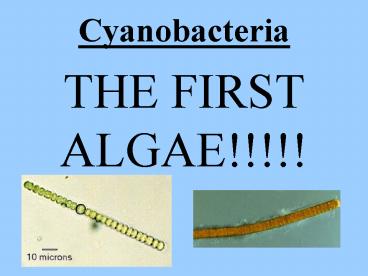Cyanobacteria - PowerPoint PPT Presentation
1 / 37
Title:
Cyanobacteria
Description:
During Proterozoic Age of Bacteria (2.5 bya 750 mya) they ... Marine littoral and pelagic. Fresh Water. Hot Springs. Terrestrial soil flora. Heterocyst ... – PowerPoint PPT presentation
Number of Views:638
Avg rating:3.0/5.0
Title: Cyanobacteria
1
Cyanobacteria
- THE FIRST ALGAE!!!!!
2
Evolution
- Old 3.5 billion years
- Dominated as biogenic reefs
- During Proterozoic Age of Bacteria (2.5 bya
750 mya) they were wide spread - Then multicellularity took over
- Cyanobacteria were first algae!
3
Cyanobacteria terminology
- - Division Cyanophyta
- - Cyanobacteria formerly known as BlueGreen
Algae - - Cyano blue
- - Bacteria acknowledges that they are more
closely related to prokaryotic bacteria than
eukaryotic algae
4
Green Plants
Red Algae
Bacteria
Animalia
Archeae
Fungi
Other Eukaryotes
Prokaryotes
Eukaryotes
5
Cyanobacteria
Brown Algae
Green Plants
Red Algae
Diatoms
Archeae
Fungi
BOTANY
6
Cyanobacteria
- Microscopic organisms
- Found in marine sediments and pelagic zone,
freshwater lakes, soils, - Live in extreme environments chemically and
temperature.
7
Importance
!!!
- 1) First organisms to have 2 photosystems and to
produce organic material and give off O2 as a
bi-product. - ?Very important to the evolution of the earths
oxidizing atmosphere .
8
Importance
- 2) Many fix or convert atmospheric nitrogen
into usable forms through Nitrogen Fixation when
other forms are unavailable. - IMPORTANT because atmospheric N2 is unavailable
to most living organisms because breaking the
triple bond is difficult
N
N
9
Cyanobacteria Characteristics
- - Pigments chl a, phycobiliproteins
- - phycoerythrin
- - phycocyanin BlueGreen Color
- - allophycocyanin
- - Storage glycogen
- - Cell Walls amino acids, sugars
10
Forms
- Unicell with mucilaginous envelope
- Colonies
- Filaments uniserate in a single row
- - OR - multiserate not TRUE branching when
trichomes are gt 1 in rows
11
Features
- Trichome row of cells
Filament
Mucilaginous sheath layer of mucilage outside
of the cell wall.
12
Features
- Mucilaginous Sheath
- Function protects cells from drying and
involved in gliding. - Sheath is often colored
- Red acidic
- Blue basic
- Yellow/Brown high salt
13
Features
- Heterocyst thick walled cell, hollow looking.
Larger than vegetative cells. - FUNCTION provides the anerobic environment for
N fixation.
H- heterocyst
14
Heterocyst
Vegetative cells
Anabaena
15
Habit success due to ability tolerate a wide
range of conditions
- Marine littoral and pelagic
- Fresh Water
- Hot Springs
- Terrestrial soil flora
16
Heterocyst
- Larger than vegetative cells
- Hollow looking
- Thick walled doesnt allow atmospheric gas to
enter. - Photosynthetically inactive
- No CO2 fixation or O2 evolution
- Formation of heterocysts triggered by
molybdenum and and low nitrogen
17
Nitrogen
- Nitrogen is a limiting nutrient necessary for the
production of amino acids building blocks of
life.
18
Nitrogen Fixation
- ONLY cyanobacteria and prokaryotic bacteria can
FIX nitrogen. - Of these two only CYANOBACTERIA evolve OXYGEN
during photosynthesis - Important because nitrogenase (enzyme involved in
fixing nitrogen) is INACTIVATED by O2.
19
Mechanisms to Separate Nitrogenase from Oxygen
- Heterocyst (spatial)
- OR
- Fix Nitrogen in the DARK but not LIGHT found in
non-heterocystic cyanobacteria (temporal)
20
AEROBIC
LIGHT
- CO2 H2O -----------? CH2O (sugar) O2
- Electrons for PS1 come from PS2 which evolves
oxygen (splitting of water)
21
ANAEROBIC in the presence of sulfer
- 2H2S CO2 --------? CH2O 2S H2O
- H2S is the electron donor so the reaction does
not produce oxygen.
22
Advantage for Cyanobacteria
- Can live in fluctuating environments of aerobic
and anaerobic with light present.
23
Cyanotoxins in Cyanobacteria
- Neurotoxins block neuron transmission in
muscles (Anabaena, Oscillatoria) - Hepatotoxins inhibit protein phosphatase, cause
liver bleeding. Found in drinking water.
(Anabaena, Oscillatoria, Nostoc) - Eg. swimmers itch - Lygnbia
24
Movement
- No flagellae or structures to enhance movement
- Excrete mucilage jet propulsion, gliding
- Helix fibers send waves of contraction
Spirulina
25
Spirulina
- filamentous
- common in lakes with high pH
- major food for flamingo populations
- commercial food source
26
- Anabaena with a heterocyst
- common bloom forming species with nutrient loads
27
Lyngbia martensiana
Releases chemicals causing dermatitis
28
Asexual Reproduction
- - Hormogonia formation -
- - Endospore / Akinete formation -
- Fragmentation
- Exospore
29
Asexual Reproduction
- Hormogonia short piece of trichome found in
filaments. It detaches from parent filament and
glides away
Hormogonia
30
- Oscillatoria with hormogonia
- short pieces of a trichome that become detached
from the parent filament and glide away to form
new filament.
31
Oscillatoria (filamentous) with hormogonia
32
Asexual Reproduction
- Akinete thick walled resting spore
33
Akinete
34
Asexual Reproduction
- Akinete thick walled resting spore
- Function resistant to unfavorable environmental
conditions. - Appear as larger cells in the chain and different
than heterocyst. Generally lose buoyancy
35
Asexual Reproduction
- Fragmentation - fragmentation
36
Oldest Fossils
- 3.5by old carbonaceous microfossils S.Africa
- 3.4by old filaments and microbial fossils W.
Australia - 3.4 by old stromatolites S.Africa, Australia
37
Cyanobacteria and Understanding the Past
Stromatolites Shark Bay, W. Australia































